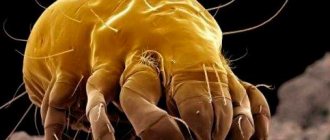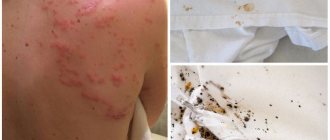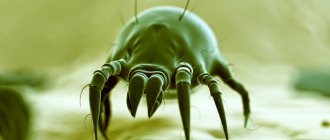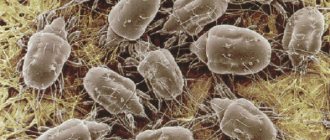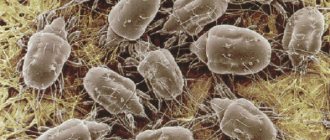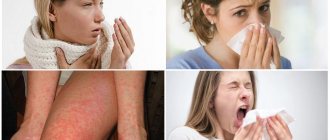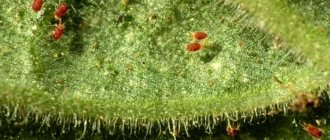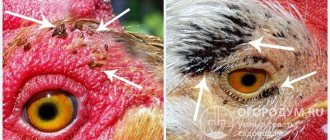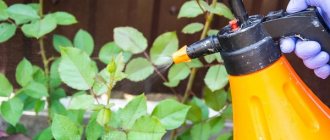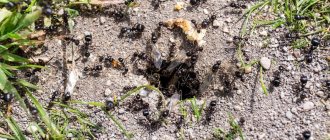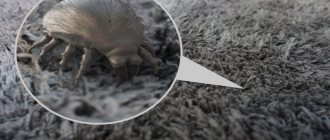Author: Elena N. https://floristics.info/ru/index.php?option=com_contact&view=contact&id=19 Category: Plant Pests Published: August 08, 2017Last edits: October 28, 2020
Currant bud mite (lat. Cecidophyopsis ribis) is a microscopic four-legged insect of the genus Cecidophyopsis of the family Eriophyidae (Trombidiformes), a common pest that lives in Europe, Asia and Australia in places where currants and gooseberries are grown. The pest damages the buds, causing the leaf mass of the bush to decrease and the shoots to develop poorly. In addition, the bud mite carries a viral disease called “terry disease” and causes degeneration of the generative organs, as a result of which the bush stops producing berries.
Description
The body of the kidney mite is worm-shaped and white. Females are about 0.3 mm long, and males are shorter - about 0.15 mm. The tick's head ends with a mouthpart similar to a wedge-shaped proboscis. The insect has two pairs of legs with feathery bristles. Tick larvae are elongated-oval, light in color.
The bud mite parasitizes black currants and gooseberries, but sometimes damages red and white currants. Ticks overwinter inside the kidneys, and one kidney can house from three to eight thousand individuals, and in large kidneys - from 8 to 30 thousand ticks. Buds occupied by a large number of pests appear larger and more convex. At the beginning of spring, they swell to the size of a pea and look like tiny heads of cabbage with deformed leaves sticking out. But those buds in which there are few ticks do not differ in appearance from healthy ones, and this makes it difficult to fight the pest.
Ticks spread both with planting material and with the help of wind, birds and other insects. Female ticks live from 20 to 45 days, each of them lays from 5 to 100 eggs. Eggs develop from one to two weeks, and larvae from one week to a month. The first generation of mites appears at the end of currant flowering. In one season, a tick produces five to six generations of offspring: two in spring and three in summer and autumn.
- Red gall aphids on currants - how to get rid of them, how to treat them
Bed mites: how to get rid of this disease?
During the day, are you constantly plagued by annoying itching, your skin is covered in red spots, and your once favorite sofa has turned into a torture chamber?
Congratulations: you have a large number of mites in your bed.
More precisely, we sympathize. Still, this is a big nuisance - bed mites. How to get rid of them?
The average size of a house dust mite is 0.2 mm. Bed ticks are so small that you won't be able to see them. They have three pairs of legs.
There are suction cups on the legs, making it almost impossible to remove live ticks in the sofa with a vacuum cleaner.
Their protective, waxy, water-repellent layer allows them to literally run on water and even pass through water droplets.
Only in combination with soap can water destroy this property.
Bed ticks are afraid of light and hide in the dust. They find their main source of nutrition in skin dandruff, which a person loses per day in the amount of 1.5 grams.
Ticks in the sofa prefer a humid-warm climate (20-25°C with an air humidity of 60-80%).
Therefore, they find the atmosphere they need mainly in the sleeping quarters. The permissible limit for mites in a sofa or in the atmosphere is 100 mites per 1 gram of dust.
When this level increases, even a healthy person may experience an allergy.
So, you have diagnosed: bed mites have settled in you after all. How to get rid of this trouble?
Experts advise ventilating more often, as well as freezing or warming bed linen, pillows, blankets and mattresses.
However, this is not always effective.
To combat bed mites, you can also change pillows, feather beds and duvets every five years. But good housewives know how expensive it is.
Another option to combat bed mites: wash the down and feathers in pillows and blankets to prolong their life and protect yourself from exposure to harmful mites.
Such services are relatively inexpensively provided by dry cleaners.
Thus, bed mites can cost a pretty penny. How to get rid of them without hurting your pocket? There is one way.
The feathers from the pillow should be carefully transferred to a bag made of loose fabric and dipped into a warm soapy solution, adding ammonia or borax to it.
For a bucket of water you need to take 50 g of soap and half a glass of ammonia or a teaspoon of borax (or boric acid).
The bag of feathers is immersed in the solution and left in it for two to three hours, turning it over and soaking it several times during this time.
Then the bag is removed and rinsed in clean water 3-4 times. Then it is wrung out and air dried, hanging on a rope.
To prevent the feathers from matting during drying, knead the stuck together lumps in the bag several times.
Well-dried feathers or down are carefully transferred to a new “napernik”, that is, a primary pillowcase made of a special fabric called “teak”.
As a last resort, you can take another material, which must be rubbed from the inside out with wax or soap, and then ironed through a rag.
The film formed on the pillowcase does not allow down and feathers to pass through the fabric.
If you find a bed tick in your apartment, you need treatment.
Scabies is an unpleasant consequence that bed mites have on humans. Treatment most often involves rubbing anti-scabies into the skin, especially carefully into the mite’s favorite localization areas.
Before starting treatment, it is advisable to take a hot shower, using a washcloth and soap, to mechanically remove mites from the surface of the skin, as well as to loosen the surface layer of the epidermis, which facilitates the penetration of antiparasitic agents.
In the presence of secondary pyoderma, water procedures are contraindicated. During treatment, washing is prohibited.
After each forced hand washing, it is necessary to re-treat them with an anti-scabies agent.
If your health has been damaged by a bed tick, treatment may consist of using a water-soap emulsion of benzyl benzoate (20% for adults and 10% for children).
The emulsion is shaken and thoroughly rubbed into the skin with a cotton-gauze swab 2 times a day for 10 minutes with a 10-minute break for two days in a row.
After treatment, change underwear and bed linen. On the third day, the patient should wash and change his underwear again.
There are many ways to treat scabies. But our advice: still see a doctor. Better yet, don’t breed ticks in your bed.
Another problem that furniture owners may encounter is bedbugs.
This type of parasite is even more unpleasant: bedbugs are blood-sucking insects. Bedbugs, unlike ticks, are very visible to the human eye, especially if these insects have thoroughly inhabited your apartment.
Bed bugs are nocturnal; during the day they hide in furniture grooves, in cracks in walls, under wallpaper, in dresses, in books, electronics, in warm and dark places, in animal and bird cages.
These insects live equally well in any room, regardless of its sanitary condition - it doesn’t matter to the bug whether the room is dirty or clean.
Typically, bed bugs attack a person in the dark, in the second half of the night, but sometimes they can become active during the day, under artificial lighting.
The bug bite itself is painless, but some time after the bite, a feeling of itching and redness appears at the site of the bite.
To kill bed bugs, insecticidal preparations are used, which can be purchased at stores selling household chemicals.
The method of their use is described on the labels.
The most effective are chlorophos, trichlorometaphos-3 (TCMP-3), karbofos in the form of a 0.3-1.0% solution, dusts “Difocarb”, “Phospholan”, “Riapan”, aerosol cans “Neofos-2”, “Piretrol- P", "Carbozol", "Prima-71".
However, experts say that there are no 100% effective methods of combating bed bugs and it is very difficult to get rid of them.
Fighting bed mites and bedbugs is not an easy and painstaking job. If you arm yourself to the teeth and show maximum patience, you will definitely succeed.
But if you don’t have the time or desire to conduct active hostilities, you can simply throw away the old furniture, with all its evil inhabitants, and buy a new sofa from the Heggi furniture store chain - just for yourself.
Examples of sofa models that you can purchase from us:
Bud mite on currants
How to fight
In the fight against kidney mites, preventive measures are very important. When purchasing seedlings, carefully inspect their buds so as not to bring a colony of pests into your garden. Ticks are repelled by phytoncides secreted by onions and garlic, so experienced gardeners recommend planting these crops in currant rows, but not digging them up in the fall, but leaving them in the soil for the winter.
For vegetative propagation of currants, cut cuttings only from healthy bushes and, just in case, disinfect them for 15 minutes in water heated to 45 ºC with the addition of indolylbutyric acid (0.5 g of the drug per 10 liters of water).
If a small number of buds are infested with mites, you can simply pick them off and burn them. If the pest’s occupation of the currant bush is total, you need to cut off and burn the entire above-ground part, and spud up the stumps. Of course, this will lead to interruption of fruiting, but soon the shoots on the bush will grow back. Make it a rule to inspect the currant every spring and remove suspicious buds, and then you will not have to cut the bushes at the root.
Remedies for kidney mites
The fight against bud mites begins in the spring: before the start of sap flow, for preventive purposes, currant bushes and the soil under them are treated with a solution of 300 g of Nitrafen in 10 liters of water. And as soon as leaves and inflorescences begin to appear on the currants, the bushes are sprayed three times at weekly intervals with biological pesticide preparations against pests: Actofit, Bitoxibacillin or Fitoverm. These treatments are only advisable at air temperatures above 5 ºC, but it is better not to spray during frosts and rainy cloudy weather.
During the transition of ticks from old buds to new ones, they can be treated with Karbofos, ISO (lime-sulfur decoction) or other preparations containing sulfur. The first spraying with two percent ISO is carried out during the period when the buds are exposed, and after 10-12 days or immediately after flowering, the bush is re-treated with one percent ISO. At the same time, colloidal sulfur is used, dissolving 100 g of the drug in 10 liters of water. Acaricides such as Endidor, Vertimek, Oberon, Nissoran, Apollo and Neoron have proven themselves well in the fight against bud pests. When processing, try to thoroughly wet all currant branches and buds with the drug solution.
How can you tell if you have dust mite allergy symptoms?
One of the main signs is nasal congestion at night, snot, and sneezing. Precisely at night. If you notice that your nose is stuffy in the morning after waking up, but it goes away during the day, then this is a clear sign of a dust mite allergy. Another sign is a reaction on the skin: redness, itchy skin. There may also be redness and watery eyes.
By the way, as CNN reports, not only you, but also your cat or dog can be allergic to dust mites. It manifests itself similarly to humans - in the form of scabies, redness of the skin, sneezing - and can occur all year round, worsening in the spring. In addition, few people know that if you allow your animals to sleep in the same bed with you, this provokes an even greater increase in dust mites.
Bud mite on gooseberries
Since gooseberries are closely related to currants, they also suffer from bud mites. How to deal with bud mite on gooseberries?
- Mealybug / Pseudococcus
Both preventive measures and chemical methods of pest control on gooseberries are the same as on currants: careful selection of seedlings, inspection of buds on bushes in early spring, removal and burning of suspicious buds, growing onions and garlic between rows and complete pruning of the bush in case of severe damage by bud mites with obligatory subsequent burning of branches. The same chemicals used to control bud mites on gooseberries can be used as on currants, and treatments should be carried out within the same time frame.
Basic methods of struggle
Dangerous insects multiply very quickly, so you need to start fighting them as quickly as possible after detecting signs of an increase in their concentration in the apartment. Insect death occurs either when the room temperature is above 60 degrees or below 10 degrees.
But in order to destroy dust mites, the following set of procedures is required:
you urgently need to get rid of all old things that have not been used for a long time - bedding, toys or clothes;- In winter, you must take pillows and blankets out into the cold at least once a week;
- if carpets are regularly vacuumed and wet cleaned, the parasite population will greatly decrease;
- soft toys in the house should be washed, taken out in the cold, or dry cleaned once a month;
- all upholstered furniture should be treated with a steam generator;
- all books in the house should be kept behind glass, and the shelves should be wet cleaned once every three days;
- bed linen should be washed once a week and be sure to iron with steam;
- skirting boards in the house need to be treated with special products once a month.
If you regularly maintain order in your home and get rid of dust in all places where it is inaccessible, then the dust mite population will be significantly reduced.
Folk remedies
If currants or gooseberries are slightly affected by the bud pest, gentle folk remedies for mite control can also be used. How to treat currants and gooseberries against bud mites?
For example, with hot water: in early spring, before the buds swell, pre-tied currant and gooseberry bushes are watered with water heated to 80 ºC in quick circular movements. This procedure not only kills ticks: hot water increases plant immunity to powdery mildew and other diseases of berry bushes, and also helps to increase yield.
Sometimes it is difficult to guess the timing and you may not have time to carry out the procedure before the sap begins to flow, but since the buds deformed by the mite are visible already at the end of August, you can douse them with boiling water in late autumn, when the leaves have fallen from the bushes.
To treat bushes against bud mites, you can use garlic water: crush 200 g of garlic, add 10 liters of water, leave for 2 hours, then treat the bushes with this mixture. Or pour 150 g of garlic peel into 10 liters of hot water and leave for 24 hours - this infusion also works well against ticks.
You can prepare a mustard infusion: leave 200 g of mustard powder in 10 liters of water for 12 hours, strain and use as directed.
Pour 200 g of dandelion roots and 50 g of leaves into 10 liters of water, let it brew for several hours, strain and process currants or gooseberries.
- How to treat plants against slugs
And tea brewing will help destroy the pest on the cuttings that you cut for propagation: 50 g of tea is brewed in 2.5 buckets of boiling water, and after a day the cuttings are dipped in this tea for 3-4 hours.
Characteristics and habitats
Dust mites belong to the category of arthropods , of which there are more than 150 species. But this is not the field tick that lives in the grass. This parasite lives in a person’s house or apartment, threatening his life and health. The size of such an insect is extremely small, which makes it impossible to examine it without a special device. He lives in ordinary room dust.
The most favorable conditions for the reproduction of the parasite are those where the air temperature exceeds 20 degrees and humidity exceeds 80%. And the greatest number of parasites accumulate in those places where cleaning is most difficult. Most often these places become:
- baseboards, shelves with books;
- bedding and the bed itself;
- carpeting on the floor;
- Stuffed Toys;
- slippers and pajamas;
- animal hair;
- vacuum cleaner bags.
The main food for ticks is dead skin cells of humans and animals. Ticks themselves do not bite and do not pose a danger to humans, but their metabolic products become the causes of most known allergic reactions.
If the number of insects per square meter of a room exceeds 500 individuals, then they become extremely dangerous to human life. The main symptoms of a mite allergy are the following:
- sneezing, constant nasal congestion;
- bouts of severe dry cough and sore throat;
- difficulty breathing, wheezing in the chest without signs of a cold;
- redness of the skin and severe itching in areas of contact with bedding.
Dust parasites can also trigger asthma and conjunctivitis. Therefore, if a person has at least one of the above symptoms, you should find out what dust mites are afraid of and how to get rid of these pests at home.
Currant varieties resistant to bud mite
In order not to start each new season with worries and worries, grow currant varieties that are resistant to bud mite on your plot. For example, these:
- Dikovinka is an early frost-resistant and productive self-fertile variety, resistant not only to bud mite, but also to powdery mildew. The berries of Dikovinka are medium-sized, oval, sweet and sour, with a strong skin. The disadvantage of this variety is the increased need for moisture;
- Selechenskaya is an early universal high-yielding drought-resistant and winter-hardy variety that combines all the advantages of gooseberries and currants. It has black, sweet, large shiny berries weighing up to 5 g with thin skin and high resistance to bud mite;
- Kipiana is a mid-late variety resistant to bud mite and powdery mildew with round, almost black sweet and sour dessert berries of medium size;
- Yadrenaya is a popular late harvest variety with oval berries the size of a cherry and weighing up to 8 g with dense, refreshingly sour pulp. Resistance to diseases and pests is high, but the variety requires regular anti-aging pruning.
Currants that are resistant to bud mite will require much less time on your part to care for. In addition, the resistance of the variety usually manifests itself against other pests.
Why is seemingly harmless nasal congestion caused by dust mite allergies dangerous?
Carelessness is one of the main problems due to which a harmless allergy in the initial stages turns into chronic asthma.
Bronchial or chronic asthma in most cases is caused by untimely treatment. Changes and destruction of the respiratory tract begin. Visually this is manifested by shortness of breath. When in contact with an allergen or with increased physical activity, attacks of suffocation may occur, leading to death. Why does this happen?
Most often due to the fact that everyone thinks “this will never happen to me.” Many people say: “I don’t eat honey by the spoonful, or citrus fruits by the kilogram – I won’t have allergies.” Even if you do not come into contact with allergens, the disease can develop.
The second mistake is when people who suspect they have an allergy begin to treat the symptoms. At night my nose is stuffy - I spray vasoconstrictor drops, and everything is fine. I ate too much food that was dangerous for myself - I took an antihistamine, and it was great. By eliminating the symptoms, you will not only never defeat the disease, but will also aggravate it so much that there is no way back.
Fighting insects in the bedroom
Most insects are localized in the human bed. Therefore, it is necessary to change bed linen as often as possible. It is advisable to do this once every three days, but if this is not possible, then this procedure should be performed at least once a week.
Bed linen should be washed at a temperature not lower than 60 degrees. Ticks will definitely die at this temperature. And fillers for pillows should be chosen only from synthetic materials, in which it is impossible for insects to breed.
In order to prevent the development of mites, do not clutter the room. There should be as little furniture in the bedroom as possible, and there should be access to all corners to wash the floor. It is better to remove office equipment from this room to prevent the accumulation of a large number of parasites in it.
The linen room should be regularly ventilated and insect repellents can be hung in it.
Signs of damage by currant bud mite
The currant bud mite mainly affects the buds of the plant. By autumn, deformed, damaged buds increase in size and begin to differ in external shape from healthy ones.
On currant bushes affected by the currant bud mite in the fall after the leaves fall, two types of buds can be clearly distinguished:
- Healthy buds, normally developed flower buds, rounded elongated and elongated leaves, covered with outer dense scales.
- Patients are swollen, round, resembling a tousled miniature head of cabbage. They are swollen with a huge number of wintering mature female ticks, which are ready to reproduce with the onset of warm weather.
During the spring-summer period:
- The change in shape, size and color of leaves on the tops of young shoots is alarming.
- The leaf blade becomes rough, leathery to the touch, light in color, and may be deformed.
- The shoot stops developing. Witches' brooms appear on the stems. This is a viral infection of plants, the carriers of which, along with other pests, are bud mites. They are carriers of viral diseases such as leaf reversal and double flower disease. There is no treatment. Diseased plants are destroyed.
Danger to humans
If treatment is not started in time, feather mites can cause acute allergic reactions or aggravate existing diseases:
- Asthma. The patient experiences attacks of the disease more often.
- Allergies are possible with a severe cough, watery eyes and runny nose. If you eliminate the allergen, you feel better and the symptoms disappear.
- Hives are accompanied by itching, and characteristic pink spots appear on the body.
- Atopic dermatitis - manifested by redness and peeling of some areas of the skin, severe itching is possible. The disease requires long-term treatment.
- Swelling of the airways is the most dangerous possible reaction, as it can be fatal.
